The Red Fulani is an African breed of cattle found from Mali across Niger and northern Nigeria to Chad and Cameroon. [1]
Contents

The Red Fulani is an African breed of cattle found from Mali across Niger and northern Nigeria to Chad and Cameroon. [1]

They are reddish-brown in colour with long lyre-shaped horns, and of the Sanga type, intermediate between Zebu and humpless cattle, with cervico-thoracic humps, though they appear more Zebu than most Sanga cattle. They are able to withstand heat, ticks, insect bites and scarcity of water and feed. Local names of the breed include Brahaza, Djafoun (Cameroon), Fellata (Chad and Ethiopia), Fogha, Gabassaé, Gadéhé, Hanagamba, Kréda (Chad), Mbororo, Rahaza, Red Fulani, Red Longhorn.
The breed is used for milk and meat production by nomadic herders in the arid Sahel. [2]

The zebu, sometimes known in the plural as indicine cattle, Camel cow or humped cattle, is a species or subspecies of domestic cattle originating in South Asia. Zebu, like many Sanga cattle breeds, differs from taurine cattle by a fatty hump on their shoulders, a large dewlap, and sometimes drooping ears. They are well adapted to withstanding high temperatures and are farmed throughout the tropics.
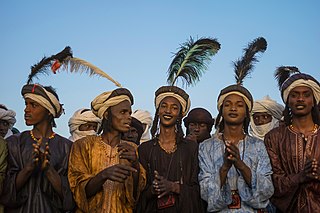
The Fula, Fulani, or Fulɓe people is an ethnic group in Sahara, Sahel and West Africa, widely dispersed across the region. Inhabiting many countries, they live mainly in West Africa and northern parts of Central Africa, South Sudan, Darfur, and regions near the Red Sea coast in Sudan. The approximate number of Fula people is unknown, due to clashing definitions regarding Fula ethnicity. Various estimates put the figure between 25 and 40 million people worldwide.

The Nguni is a cattle breed indigenous to Southern Africa. A hybrid of different Indian and later European cattle breeds, they were introduced by pastoralist tribes ancestral to modern Nguni people to Southern Africa during their migration from the North of the continent.
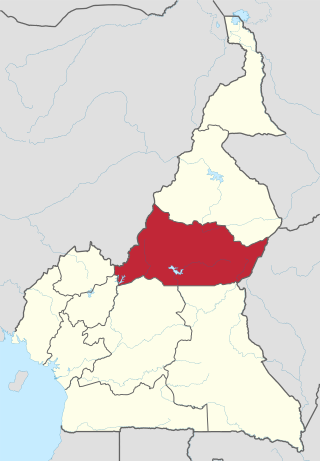
The Adamawa Region is a constituent region of the Republic of Cameroon. It borders the Centre and East regions to the south, the Northwest and West regions to the southwest, Nigeria to the west, the Central African Republic (CAR) to the east, and the North Region to the north.
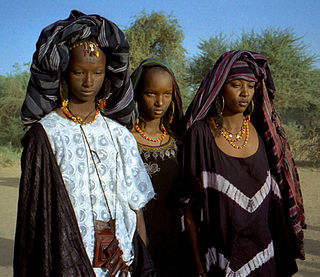
The Wodaabe is a name that is used to designate a subgroup of the Fula ethnic group who are traditionally nomadic found primarily in Niger and Chad. All Woodabe people should not be mistaken as Mbororo as these are two separate subgroups of the Fulani people. It is translated into English as "Cattle Fulani", and meaning "those who dwell in cattle camps". The Wodaabe culture is one of the 186 cultures of the standard cross-cultural sample used by anthropologists to compare cultural traits. A Wodaabe woman, Hindou Oumarou Ibrahim, was also chosen to represent civil society of the world on the signing of Paris Protocol on 22 April 2016.
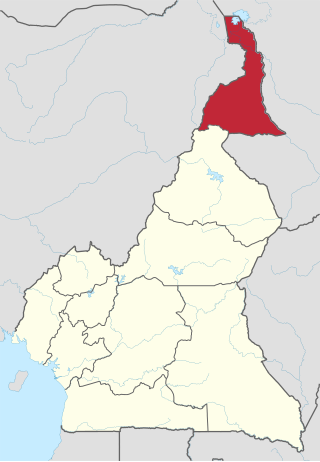
The Far North Region, also known as the Extreme North Region, is the northernmost and most populous constituent province of the Republic of Cameroon. It borders the North Region to the south, Chad to the east, and Nigeria to the west. The capital is Maroua.
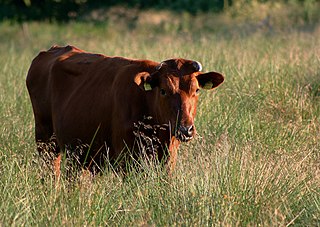
Danish Red cattle, also known as Red Danish or Red Dane, are a major dairy cattle breed in northern Europe. There are 42,599 pedigree cows in Denmark. They can be used as a beef breed once they finish their useful lifetime.
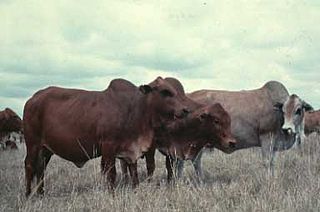
Boran cattle are a popular Zebu beef breed in eastern Africa.
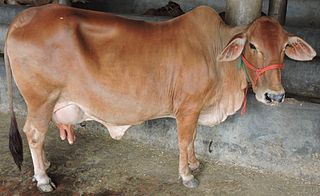
Sahiwal cattle is a breed of Indian zebu cow, named after the Sahiwal district of modern-day Pakistan.. The cattle is mainly found in Punjab province of Pakistan, and Indian states of Punjab, Haryana, & Rajasthan.

'Sanga cattle is the collective name for indigenous cattle of sub-Saharan Africa. They are sometimes identified as a subspecies with the scientific name Bos taurus africanus. Their history of domestication and their origins in relation to taurine cattle, zebu cattle (indicine), and native African varieties of the ancestral aurochs are a matter of debate. "African taurine", "sanga", "zenga", "sheko", "African indicine" are all sub-groups of Sanga cattle.
White Fulani cattle are an important beef breed of cattle throughout the area conquered by the Fulani people and beyond in the Sahel zone of Africa. They are mostly Zebu but of Sanga cattle origin. Characterized by high lyre shaped horns, they have either thoracic humps like the Zebu or humps intermediate with the cervico-thoracic humps of the Sanga.
Jamaica Hope is a dairy breed of cattle originating from Hope Farm in Jamaica.

The Kuri is a breed of the humpless longhorn group of cattle. The humpless longhorn grouping relates them to the N'dama cattle. They are used for meat, milk and work. They are intolerant of heat, sunlight, and can not stand long periods of drought. They are good swimmers and spend much of their time in Lake Chad. Despite their heavy weight, ranging anywhere from 800 to 1100 pounds, some believe what helps their swimming abilities is their unusual horns.

Fulani herdsmen or Fulani pastoralists are nomadic or semi-nomadic Fulani people whose primary occupation is raising livestock. The Fulani herdsmen are largely located in the Sahel and semi-arid parts of West Africa, but due to relatively recent changes in climate patterns, many herdsmen have moved further south into the savannah and tropical forest belt of West Africa. The herdsmen are found in countries such as Nigeria, Niger, Senegal, Guinea, Mauritania, Mali, Burkina Faso, Ghana, Benin, Côte d'Ivoire, and Cameroon. In Senegal, they inhabit northeastern Ferlo and the southeastern part of the country. In some of these countries the Fula constitute a minority group. They inhabit Northern Nigeria and some parts of the country.

The red and black coated Arado cattle are small and hardy. They are the most common cattle variety in the north Ethiopian highlands. The Arado breed is part of the Zenga breed group. It is essentially reared for draught power, particularly tillage. The breed feeds mainly on crop residues; it is adapted to seasonal feed shortages. This breed is often cross-bred through bull and artificial insemination services.

The long-horned Raya cattle are a breed of cattle common in the Tigray Region of Ethiopia. The Raya cattle have red and black coat colours. Bulls and oxen have thick and long horns and a cervicothoracic hump; cows have medium, thin horns. Raya cattle are closely related to the Afar cattle; this is a result of historical cattle raiding by the Raya people. The Raya cattle are however adapted to draught animals for tillage in the croplands of the highlands.
The Afar cattle are mainly found on the western margins of the Danakil Depression in Ethiopia. The Afar cattle have thick and long horns and a cervicothoracic hump; they are essentially reared for milk production.

The Abergele cattle are the smallest breed of cattle in north Ethiopia. They are reared in the Abergele lowlands and at the southwestern lower slopes of Dogu'a Tembien district. Abergele cattle are part of the Zenga breed group. The Abergele breed is known for its adaptation to the hotter and drier lowlands. It is also very tolerant to diseases and parasites and can cope with feed shortages during long dry periods.
Begayt is an Ethiopian breed of cattle. Currently there are ongoing cross-breeding programmes with Arado cattle, in an attempt to increase the milk production of the latter.
Fogera cattle is an Ethiopian breed of cattle. One of its typical characteristics are broad hoofs, that allow it to move more easily in the marshes of the Fogera Plain. At Woreta, the agricultural research centre specialises in preserving the breed.